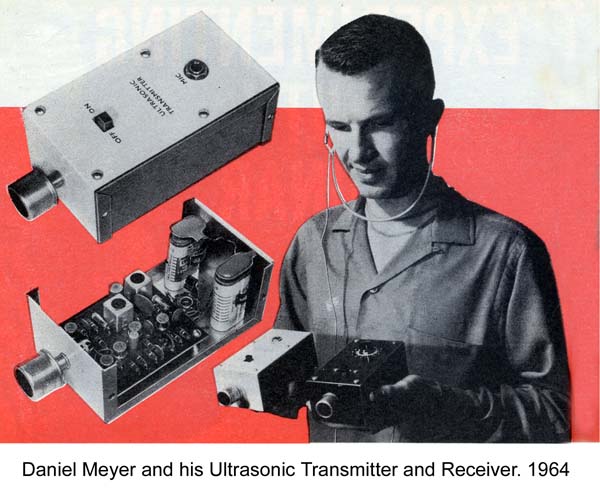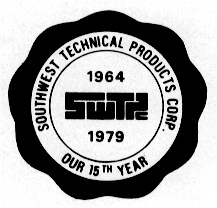
Additional SWTPC personal histories.
| The cover story on March 1963 issue of Popular Electronics was an article written by Daniel Meyer. It was on how to build an Ultrasonic Sniffer that allowed you to listen to sounds from 38 to 42 kc. (This was before "cycles per second" were called Hertz.) You could order the printed circuit board from Daniel Meyer at his home address in San Antonio, Texas. (He had been writing articles since 1959.) |
.

 In
January 1964 Dan left his job at Southwest Research Institute and went
into the electronics kit business. That year Dan had three more articles
in Popular Electronics. In 1965 he started using the name DEMCO (Daniel E. Meyer
Company). To grow the business, DEMCO started selling kits for articles by other
authors, such as Louis E. Garner Jr. and later Don Lancaster. In 1967 the
company was incorporated as Southwest Technical Products Corporation. In
January 1964 Dan left his job at Southwest Research Institute and went
into the electronics kit business. That year Dan had three more articles
in Popular Electronics. In 1965 he started using the name DEMCO (Daniel E. Meyer
Company). To grow the business, DEMCO started selling kits for articles by other
authors, such as Louis E. Garner Jr. and later Don Lancaster. In 1967 the
company was incorporated as Southwest Technical Products Corporation.At first the business was run from Dan's garage. His housekeeper, Lucy Proctor, would drill the circuit boards and package the kits. (Lucy worked at SWTPC until 1987.) In early 1967 the company moved to a 4 acre site located at 219 W. Rhapsody, San Antonio, Texas. Over the years this grew to a complex of 8 buildings (68,000 square feet). SWTPC had a print shop, a metal shop, a wood shop, a PCB fab (single sided) and everything else need to build kits. The company grew to over 100 employees. Around 1980 the audio kits were dropped to focus on computers. Business started to decline around 1983 and there was a major layoff in 1987. A small group continued on until 1990 providing parts and service. The company became Point Systems and made point of sale (cash register) equipment for a couple of years. SWTPC provided 7 of the 12 cover stories for Popular Electronics in 1967. These included such classics as Louis Garner's Theremin and Dan Meyer's L'il Tiger amplifier Don Lancaster had 4 covers. Between 1963 and 1975 Popular Electronics published over 75 SWTPC project articles with over 30 cover stories. The late 1960s was a real boom time for electronics' hobbyist and kit sellers. The constructions articles had shifted from vacuum tubes to solid state (transistors and integrated circuits.) While tube projects were built with point to point wiring, ICs required a printed circuit board. SWTPC projects always had a circuit board and often needed an uncommon part. A dedicated hobbyist could scratch build the project, most people just ordered the kit. Heathkit sold kits that anyone could assemble, the detailed instructions assumed no knowledge electronics. Dan Meyer referred to those as "paint by number" kits. The kits that SWTPC sold required an ability to read a schematic and identify components. In 1970 SWTPC started advertising in small ads in electronics magazines. They also started their 9x6 inch 30 page catalogs. These catalogs showed the diversity of kits they produced. Not all of the magazine projects made it into the catalogs. Some of the projects were very enduring and were sold for years and years. In the first 10 years SWTPC the most popular products were audio kits followed by test equipment. There was also that very 70's stuff like color organs that would synchronize colored lights with music and strobe lights. Dan Meyer developed a series of audio power amplifiers known as Tigers. These amps are still in use today. Don Lancaster developed a series of decimal readout counters and voltmeters that used the latest technology. In September 1973, Radio-Electronics published Don Lancaster's "TV Typewriter". This caught the imagination of hobbyist but used hard to find parts and was not a complete terminal. Dan Meyer asked Ed Colle to design a low cost computer terminal that was easy to build. The CT-1024 Terminal was introduced in the January 1975 issue of Popular Electronics on the facing page to the Altair 8800 computer. SWTPC was now in the computer kit business. In mid 1975 Dan Meyer asked one of his engineers, Gary Kay, to design a computer based on the Motorola 6800 design kit. Flyers for this computer when out in August 1975 and the first deliveries were in November 1975. Sales of the SWTPC 6800 Computer were fantastic but the software was limited. In early 1976 Robert Uiterwyk called SWTPC and asked if they would sell his BASIC interpreter. In June of 1976 SWTPC introduced the AC-30 Cassette Interface for data storage and the PR-40 printer. You could now get a complete computer system for about $1500. Many of the early hobbyist computer company were founded by engineers who did not know how to run a business. They would fold in a year or so. SWTPC had been successful in the kit business for over a decade so they could deliver working products. Floppy Disk systems, full feature terminals, and many peripherals were added in 1977. The bus structure was called the SS-50 bus and soon many other vendors were making add in cards and complete systems. In 1979 SWTPC introduced a new line based in the Motorola MC6809 processor. These systems were produced until the late 1980's. By then the IBM PC was dominating the personal computer world and SWTPC shifted to point of sale systems. Dan Meyer died in May 1998. Don Lancaster, Ed Colle, Gary Kay and Robert Uiterwyk are still here in November 2005. |
Dan Meyers magazines atricles (1959-1975)
Note from Gary Kay about the SWTPC 6800 Computer
San Antonio EXPRESS/NEWS profile of SWTPC 1972
Dan Meyer's December 1974 Letter; CT-1024 Terminal and Datapoint 2200 computer.
Wayne Green's Visit to SWTPC in August 1975
Interview with Daniel Meyer in Creative Computing 1977
Note from Ed Colle on the TV Typewriter